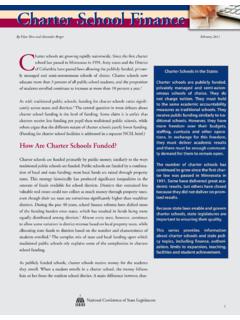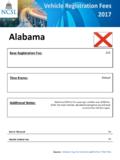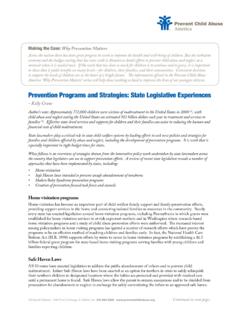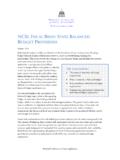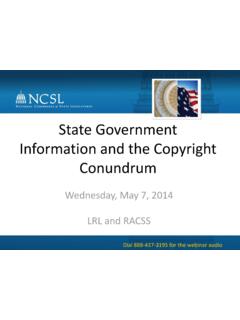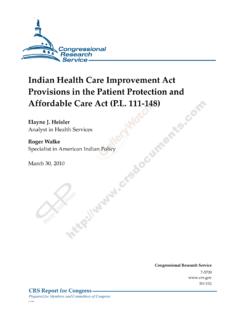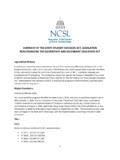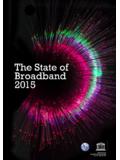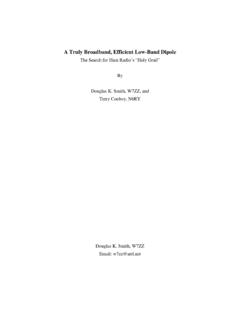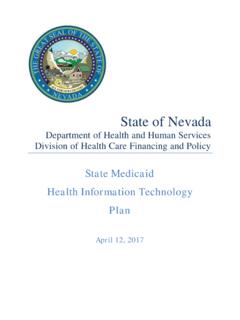Transcription of National Conference of State Legislatures
1 Page | 2 National Conference of State Legislatures William T. Pound, Executive Director 7700 East First Place Denver, CO 80230 444 North Capitol Street, , Suite 515 Washington, DC 20001 November 2015 Page | 3 The National Conference of State Legislatures is the bipartisan organization that serves the legislators and staffs of the states , commonwealths and territories. To improve the quality and effectiveness of State Legislatures . To promote policy innovation and communication among State Legislatures . To ensure State Legislatures a strong, cohesive voice in the federal system. NCSL provides research, technical assistance and opportunities for policymakers to exchange ideas on the most pressing State issues and is an effective and respected advocate for the interests of the states in the American federal system.
2 Page | 4 Foreword As part of its continuing mission to examine tax issues of importance to the states , the National Conference of State Legislatures (NCSL) Executive Committee Task Force on State and Local Taxation held a series of panels in 2013 and 2014 regarding tax issues affecting the deployment of broadband communications infrastructure. These efforts resulted in the adoption of a Task Force resolution in November 2013 that encouraged states ..who wish to encourage broadband deployment consider exempting communications network equipment from the sales and use tax. As the Task Force examined the more complex property tax issues related to communications infrastructure, members decided that an in-depth examination of these property tax issues would benefit State policymakers.
3 The Task Force directed NCSL staff to work with interested stakeholders to draft a white paper that examined key property tax issues related to communications infrastructure. The report would include an overview of State practices and an examination of recent State reforms to modernize property tax systems in ways that encourage broadband deployment and achieve tax parity among competing providers of telecommunications services. This white paper relies on previous publications by the NCSL Fiscal Affairs Program which examine, in general terms, the role of property taxes in State and local finance. It provides a high-level overview of key issues related to the property tax while focusing specifically on property tax provisions related to the communications industry. For additional detail on property tax systems generally, the bibliography highlights a number of reports from NCSL and other sources.
4 Page | 5 Introduction and Overview Historically, property taxes have, and continue to be, the primary revenue source for local governments in the United states . However, State constitutions and statutes determine the rules under which local governments determine property values, set tax rates, levy and collect property taxes, and adjudicate disputes between taxpayers and taxing jurisdictions. Therefore, State Legislatures play a critical role in determining how property taxes impact residential and business property owners. Additionally, as states have established a much greater role in funding education over the past three decades, State laws to ensure property tax uniformity across local jurisdictions have become increasingly important to ensure equity in school funding. Reliance on property taxes has been declining nationwide since the depression.
5 However, the shift in reliance away from property taxes accelerated in the late-1970s when voters in California approved Proposition 13, which rolled back property taxes to 1% of value and limited valuation growth to 2% per year. Property taxes were and remain very unpopular with voters, and other states followed California s lead. Reliance on property taxes fell from 26% of State and local revenue in the late 1980s to 17% in 1998 roughly where they remain today. State and Local Government Revenue by Source, 1977-2010 Source: Tax Policy Center; Census Bureau, Governments Division This report highlights ways that State property tax policies result in disproportionately high tax burdens on communications providers as compared to other competitive businesses. It examines how some states have modernized their tax policies to balance the need for tax revenues with the important economic benefits that accrue from private sector investment in communications infrastructure.
6 Page | 6 Specific Property Tax Policy Issues Related to Communications Infrastructure There are three types of property that may be subject to property taxes: Real property is generally defined as land plus buildings and structures permanently affixed to the land. Real property is typically taxable in every State , whether owned by a business or by an individual. Personal property is generally defined as property that has a physical form or substance but not permanently affixed to the land, such as machinery and equipment. Most states tax personal property owned by a business while exempting personal property owned by individuals. Intangible property is generally defined as property that does not have physical form or substance. Examples include stocks, bonds, cash, copyrights, trademarks, goodwill, and licenses. Most states exempt intangible property by constitution or statute, although as discussed further in this section, valuation methods used by some states can have the effect of including intangible property in the tax base.
7 Property taxes are typically imposed on the fair market value of property, commonly defined as the price an informed, willing buyer would pay a willing seller. However, states sometimes deviate from this principle when determining the value of telecommunications property, such as: Assessing telecommunications property on the basis of the enterprise value as a unit, which can result in taxation of more than the actual value of tangible property by including significant intangible value, even in states where intangibles are statutorily or constitutionally exempt from taxation; and Applying assessment ratios that result in the taxation of a higher percentage of fair market value compared to other general businesses; and Defining the personal property of telecommunications providers as real property so that it is taxable in states that do not tax personal property. These practices, either individually or in combination, often result in higher effective tax rates on the property of telecommunications companies as compared to other general businesses.
8 Page | 7 Unit Valuation and the Taxation of Intangible Assets of Telecommunications Companies In most states , the value of business property is determined by local municipal or county assessors. However, in the case of telecommunications property, property values may be determined at the State level by the Department of Revenue or State Tax Commission a procedure known as central assessment. Central assessment is not a problem in and of itself, as it may be more efficient for a single entity with specialized expertise to value such property and it may be easier for a telecommunications company to deal with a single assessor than multiple assessors. In discussing central assessment in its September 2014 report entitled The Best and Worst of International Property Tax Administration, the Council on State Taxation (COST) noted that: Property tax system administration is fairest for the taxpayer when it is consistent throughout a jurisdiction.
9 If different municipalities or other governmental sub-units within the same jurisdiction follow different rules, taxpayers can be disadvantaged. Strong central oversight is necessary for a fair and efficient property tax system. The State of Maryland sets a good example for requiring consistency across the State . However, telecommunications property that is centrally assessed is sometimes valued using the unit value methodology. The unit value methodology was developed in the mid-nineteenth century for the property of a railroad where it was difficult to value the property in a jurisdiction by looking at just the property situated in that jurisdiction in isolation. The concept of valuing the entire system of assets was born and commonly referred to as the unit valuation. This concept was extended to public utilities. The unit valuation approach raises the question should the property tax system value the business enterprise or its property?
10 The unit valuation approach assumes a regulated business will earn its authorized rate of return. It values public utility monopolies based on the connection that existed between the investment in tangible assets by a monopoly provider (its rate base ) and the rate of return that a regulatory body allowed it to earn on that investment. In other words, the monopoly provider s earnings were directly related to its investment. Today, the old rate regulated telecommunication company is a thing of the past. Telecommunications companies offer a wide variety of services and products and competition has replaced rate of return regulation. Companies providing advanced telecommunications services, such as cloud computing and other Internet-based services that are available today, have no regulatory mechanism that provides a guaranteed rate of return on investment.

